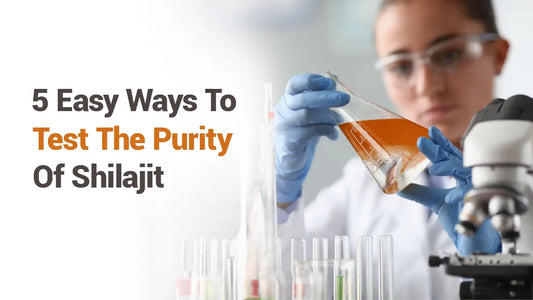Aug 22, 2025
Shilajit is only formed in the high altitude regions, and among many countries, Nepal is known to produce one of the most authentic ones in the market. What makes our Everest Shilajit even more exceptional is that our products are extracted from >18,000 feet.
This altitude never touched by human activities is more than just a location, it's the beginning of purity itself. Looking inside the product’s constituents, what we see is a rich profile of antioxidants, which is the hallmark of shilajits found in Nepal.
Compounds That Make Shilajit Powerful
Shilajit is a powerhouse of bioactive compounds- a result of centuries of compressed plant, soil minerals and microbial matters decomposed under mountain pressure. At its core, humic substances and a spectrum of minerals, vitamins and antioxidants make it a powerful supplement.
-
Humic substances: Fulvic acid, humic acid, humins
-
Non-humic substances: Dibenzo-α-pyrones, amino acids, fatty acids, phenolics, minerals, trace minerals
Antioxidants: What Do They Do?

Antioxidants are compounds present specifically in natural substances like fruits, vegetables, and also in natural mineral-rich substances like shilajit. There's a very small chance that most supplements we purchase have enough of them, but this natural supplement is pure magic- more than 60% of the constituents are antioxidants.
As per the name, antioxidants act against free radicals that cause oxidative stress in the body, which after a certain level can harm the body’s own cells, proteins and DNA, The core functions of antioxidants can be summarized as:
-
Protection against oxidative stress
-
DNA damage prevention
-
Skin health and anti-aging
-
Athletic performance and recovery
Antioxidants Present In Shilajit: fulvic acid, Dibenzo-α-Pyrones (DBPs), phenolic compounds, flavonoids, carotenoids
ORAC Values of Shilajit
ORAC (Oxygen Radical Absorbance Capacity) is a lab test to measure how well any food/ substance can fight free radicals. Higher ORAC means more antioxidants in the food. It’s measured in micromoles of Trolox equivalents (µmol TE) per unit of weight or volume.
The ORAC, being an in vitro test, is considered limited or obsolete and no longer used by the USDA. Its popularity in marketing, however, remains the same.
Let's have a look at the ORAC values of shilajit and different superfoods:
| Food/ Substance | ORAC (µmol TE / 100g) |
|---|---|
| Shilajit | 5,000 to 50,000 |
| Berries and Prunes | >13,000 |
| Cloves | >250,000 |
| Oregano | >175,000 |
| Dark chocolate | ~50,000 |
Shilajit’s high value hence positions it favorably against many antioxidant-rich superfoods.
Source of Antioxidants In Shilajit
Nepal’s shilajit including Everest Shilajit has a robust antioxidant profile compared with other regional variants. The answer to “How?” can be explained by the source the formation:
Plants: The high altitude has the best and unique range of flora needed for the formation. Euphorbia royleana, Trifolium, Rhus, Ficus, and Juniperus are abundantly present in the heights from where we extract shilajit. These plants are a source of high levels of antioxidants and shilajit inherits and concentrates these powerful plant-based antioxidants.
Soil: Soil is the source of minerals in shilajit. The Himalayan soil is mineral-dense, enriched over millennia by the geological activity in the Himalayas. These minerals have antioxidant properties hence shilajit serves as a natural reservoir of antioxidants.
Microbes: Shilajit’s formation is also dependent on microbial population of the high altitude, as they metabolize plants and soils back there, they form organic acids and other constituents, increasing the potency of shilajit. Without an abundance of specific microbes, the formation of phenolic/ dibenzo-α-pyrone and other low molecular weight compounds is almost impossible.
Extraordinary Antioxidant Properties of Everest Shilajit
- Fulvic acid: It regenerates antioxidants and scavenges free radicals, prevents diabetes, Alzheimer’s and cardiovascular diseases.
- Phenolic compounds: They reduce inflammation and prevent cancer, heart disease and metabolic syndrome.
- Flavonoids and their derivatives: They help chelate metals, modulate enzymes and scavenge free radicals, reduce risks of neurodegenerative diseases, diabetes and inflammation.
- Synergistic effects of combined compounds: A synergistic network of fulvic acid, phenolics, flavonoids, and essential trace minerals. Multiple cellular targets are protected by the interaction. support endogenous antioxidant systems.

DID YOU KNOW?
Antioxidants prevent chronic diseases that normally occur due to systemic inflammation, oxidative stress, and immune dysregulation in the body, some common ones include diabetes, cardiovascular disorders, arthritis, and chronic fatigue syndrome.
Scientific Research and Evidence
- Shilajit showed 95% to 97% free radical (named DPPH) scavenging. Except neutralizing the free radical, regeneration of vitamin C was also observed.
- Shilajit in diabetes patients revealed decreased markers of lipid peroxidation. This indicates measurable antioxidant effects in humans. The lower the marker, the better the antioxidant protection against diabetes related complications like nerve damage, heart disease, and kidney issues.
- In an animal study where the focus was on alcohol induced liver injury, consumption of shilajit was linked to reduced markers of oxidative stress and increased key antioxidant enzymes, which resulted in less liver damage.
https://www.ijaprs.com/index.php/ijapr/article/view/1512
- In studies done in labs, fulvic acid was able to inhibit tau protein aggregation, a hallmark of Alzheimer’s disease pathology.
https://pubmed.ncbi.nlm.nih.gov/22482077/
- A trial study involving postmenopausal women with osteopenia showed that consuming 500 mg/day of shilajit extract for 48 weeks reduces inflammation and oxidative stress. An increase in bone mineral density was also observed in the study subjects.
https://pubmed.ncbi.nlm.nih.gov/35933897/
FAQs
Q. Does Shilajit have antioxidants?
A. Yes, shilajit has a number of antioxidants in an abundant amount. The main ones include fulvic acid, humic acid, dibenzo-α-pyrones, and polyphenols.
Q. Is Shilajit found in Nepal?
A. Yes, shilajit is found in Nepal. The ones extracted here have the best composition in terms of beneficial compounds and the fact that >18,000 altitude regions present here means the most potent shilajit is found in this country.
Q. Is Shilajit high in antioxidants?
A. Yes, shilajit is high in antioxidants. Almost 60 to 80% of shilajit is fulvic and humic acid, the main known bioactive compounds of shilajit.
References:
https://zestlab.com.np/preserving-the-purity-of-shilajit-an-ancient-remedy-for-modern-times/
https://ejabf.journals.ekb.eg/article_312094_1586e4ea967d44f4593d1d0c1f70a25d.pdf
https://europepmc.org/article/PMC/3296184
Written By:

Authentic Shilajit sourced from the Himalayas of Nepal
Everest Shilajit is a premium wellness brand founded by Pragya Mahara, offering authentic Himalayan Shilajit resin sourced at high altitudes. With over a decade of global business experience, Everest Shilajit blends ancient Ayurvedic tradition with modern quality standards to deliver pure, lab-tested Shilajit worldwide.
Disclaimer
The content provided in this blog is for informational and educational purposes only. It is not intended to be a substitute for professional medical advice, diagnosis, or treatment.








